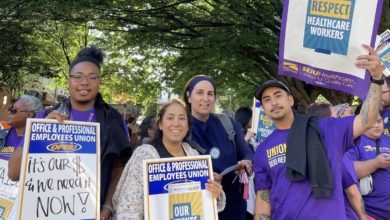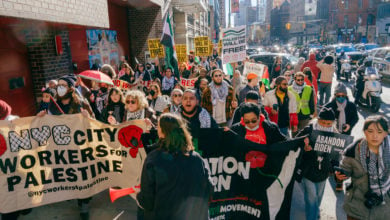All over the United States, increased poverty is becoming more and more evident. Poverty rates in some areas have reached massive levels, as in Rochester, N.Y., where 30 percent of the population lives in poverty.
 Photo: James Carroll |
Even in states like Florida that are reportedly experiencing an “economic boom,” tens of thousands are falling below the poverty line. The pauperization of working people in the United States is also shown by the record increase in bankruptcies, a record lack of access to health care, stagnant wages and skyrocketing housing costs. Meanwhile, corporate profits continue to soar.
The poverty threshold for a family of four is an annual income of $19,971 as defined by the U.S. Office of Management and Budget. The income thresholds decrease for smaller families: $15,557 for families of three and $9,973 for individuals.
If the poverty line were defined by the inability of workers to afford decent housing, health care and adequate nutrition, the number of those living in poverty would increase by millions.
The 2005 census reported that 37 million people live in poverty in the United States, nearly 13 percent of the population. Measuring poverty by the income threshold alone, that is not a significant increase from 2004. When other living conditions are taken into account, the picture is quite different.
The poverty line only calculates family income but does not take into consideration increases in the cost of living. In 2005, the number of people without health insurance hit an all time high of 46.6 million—that is 1.3 million more than the previous year. Housing, food and energy costs have all significantly increased, making all these daily needs more and more inaccessible.
“The poverty guidelines are very outdated and unrealistic,” said Lisa Travis, advocacy and education coordinator for the Indiana Institute for Working Families. “A person needs to earn nearly 200 percent of the poverty level just to make ends meet in Indiana.”
This is the reason so many children live in poverty. Forty-two percent of single mother households with children under 5 years old live in poverty. It is an increase from 2004, when 26 percent of such households were living in poverty.
The discrepancies increase for African Americans. Nearly 1 million African Americans have slipped into poverty since 2004.
Do workers have less because there is less to go around? Not by a long shot. Profits are increasing for the capitalist class each year. The single most important contributor to escalating profits “has been a decline in labor’s share of the national income,” according to economists at Goldman Sachs, one of the world’s largest investment banks.
 Wal-Mart, the country’s largest employer, pays on average less than $10 per hour. Photo: Ruaridh Stewart |
U.S. workers have increased productivity by 16.6 percent during the past five years; yet workers’ total compensation rose only 7.2 percent. This means that corporations have been extracting more money from workers’ labor—the real reason for increased poverty.
Hidden truths: Florida and Hawaii
Florida is lauded by bourgeois politicians and the media as one state where the economy is booming. Florida has been a center of job growth—most are low-wage jobs and construction. Despite this growth, the census reports that since the previous year more than 150,000 additional people have fallen below the poverty line.
There are also increases in people seeking food assistance, and those lacking healthcare coverage. Many cannot afford housing either. The average cost of a home in south Florida hovers around $380,000, making down payments on even the most modest homes or condominiums unreachable for the vast majority of people.
In addition, Miami has the third highest rate of poverty after Detroit and Cleveland—two cities devastated by the shift away from manufacturing towards a high-tech, service economy.
Hawaii provides another example of how living conditions are sliding. On paper, Hawaii has one of the highest median incomes in the nation. In 2005, there was an increase of 8.5 percent. But this would be looking at income in a vacuum. When these figures are adjusted for inflation, the state’s median income of $58,112 last year—the fourth highest in the nation—actually falls below the median income from six years ago.
Even though the census shows an apparent decrease in poverty, the monthly income of $1,664 for a family living at the poverty line would not come close to meeting basic needs of housing, transportation, food and clothing.
The outrageously high cost of living in Hawaii also is not factored into this equation. Hawaii’s cost of living is an estimated 30 to 60 percent more than the rest of the country. This is, in part, due to the continued colonial-style relationship Hawaii has with the mainland United States. Over 90 percent of Hawaii’s food is imported, and there is never more than a seven-day supply of perishables.
Significant poverty increases abound
While Miami and Honolulu are hardly the shining stars of capitalist progress, other regions present statistics nothing short of alarming. According to a Fiscal Policy Institute analysis of census data, the working-class city of Rochester, N.Y., has an estimated 30 percent of its population living in poverty—more than three times the average of other areas in central New York. In a city that houses Eastman Kodak, Wegmans Food Markets, Bausch & Lomb and other large corporations, this increase in poverty is due mostly to job loss.
“Of those using food banks in the Rochester area, 31 percent of the households include at least one employed adult; 43 percent of the households are from suburban or rural areas; 54 percent of the clients are white, 38 percent African American and 7 percent Hispanic/Latino. Thus the poor and hungry represent a broad cross-section of the community,” writes Don Pryor on the Third Presbyterian Church website. “The onset of conditions leading to poverty and hunger can occur very quickly.”
The situation in smaller cities like Rochester is dire enough. But two south Texas counties present the lowest median incomes nationwide. Cameron and Hidalgo counties had the lowest median household incomes for places with populations larger than 250,000, according to the 2005 American Community Survey. Both Hidalgo County’s and Cameron County’s median household incomes were only 53 percent of the national median of $46,242.
“Texas is plagued by poverty. Texas continues to be a low-wage, low-benefits state, and our high poverty rates reflect that,” said Eva Deluna Castro, a senior budget analyst with the Center for Public Policy Priorities.
Bankruptcies not deterred by draconian laws
Yet another sign that U.S. workers are worse off now than they were even a few years ago is the overall increase in bankruptcy filings. Despite stricter laws passed by Congress in 2005, bankruptcy filings have risen 54 percent in the second quarter, compared to the previous three months of 2006.
The draconian features of the new bankruptcy laws have failed to address the core issues involving people’s need to file. After the new laws went into effect in November 2005, bankruptcy filings initially dropped. However, it did not take long for the rate to increase four-fold, according to Chris Lundquist, founder of a consulting firm that follows bankruptcy trends.
The overall amount of outstanding credit card debt is four times more than in 1990, amounting to $696.7 billion. Workers are not seeking bankruptcy as a way out of unpayable debt to embark on extravagant cruises and to have jet-setter lifestyles. The vast majority report job loss and high healthcare expenses as the main reasons for their unmanageable debt. People who fall behind on their credit card payments are further penalized—sometimes with rates of over 30 percent.
In the run-up to this November’s mid-term elections, not a peep has been uttered by Republican or Democratic candidates about the looming poverty crisis. Candidates from both parties are beholden to their corporate masters’ interests and strategies—the extraction of massive profits by depressing workers’ living conditions and the support of imperialist war to control markets and secure wealth.
Workers of all nationalities in the United States can make alleviating poverty and increasing workers’ benefits and power part of the political agenda. Building class consciousness and working-class unity and organization will help us accomplish these goals, hastening capitalism’s inevitable demise.
(First published on pslweb.org, Sept. 5, 2006)






